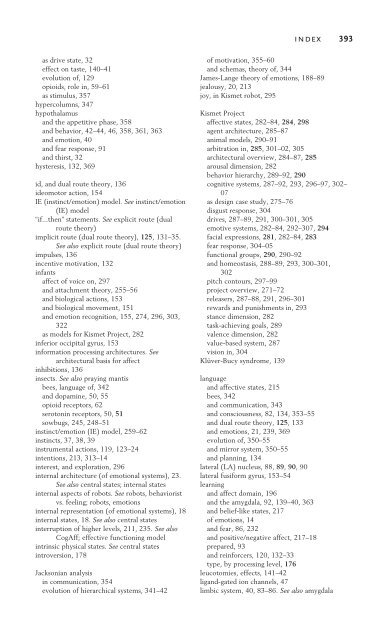Who Needs Emotions? The Brain Meets the Robot
Who Needs Emotions? The Brain Meets the Robot
Who Needs Emotions? The Brain Meets the Robot
You also want an ePaper? Increase the reach of your titles
YUMPU automatically turns print PDFs into web optimized ePapers that Google loves.
as drive state, 32<br />
effect on taste, 140–41<br />
evolution of, 129<br />
opioids, role in, 59–61<br />
as stimulus, 357<br />
hypercolumns, 347<br />
hypothalamus<br />
and <strong>the</strong> appetitive phase, 358<br />
and behavior, 42–44, 46, 358, 361, 363<br />
and emotion, 40<br />
and fear response, 91<br />
and thirst, 32<br />
hysteresis, 132, 369<br />
id, and dual route <strong>the</strong>ory, 136<br />
ideomotor action, 154<br />
IE (instinct/emotion) model. See instinct/emotion<br />
(IE) model<br />
“if...<strong>the</strong>n” statements. See explicit route (dual<br />
route <strong>the</strong>ory)<br />
implicit route (dual route <strong>the</strong>ory), 125, 131–35.<br />
See also explicit route (dual route <strong>the</strong>ory)<br />
impulses, 136<br />
incentive motivation, 132<br />
infants<br />
affect of voice on, 297<br />
and attachment <strong>the</strong>ory, 255–56<br />
and biological actions, 153<br />
and biological movement, 151<br />
and emotion recognition, 155, 274, 296, 303,<br />
322<br />
as models for Kismet Project, 282<br />
inferior occipital gyrus, 153<br />
information processing architectures. See<br />
architectural basis for affect<br />
inhibitions, 136<br />
insects. See also praying mantis<br />
bees, language of, 342<br />
and dopamine, 50, 55<br />
opioid receptors, 62<br />
serotonin receptors, 50, 51<br />
sowbugs, 245, 248–51<br />
instinct/emotion (IE) model, 259–62<br />
instincts, 37, 38, 39<br />
instrumental actions, 119, 123–24<br />
intentions, 213, 313–14<br />
interest, and exploration, 296<br />
internal architecture (of emotional systems), 23.<br />
See also central states; internal states<br />
internal aspects of robots. See robots, behaviorist<br />
vs. feeling; robots, emotions<br />
internal representation (of emotional systems), 18<br />
internal states, 18. See also central states<br />
interruption of higher levels, 211, 235. See also<br />
CogAff; effective functioning model<br />
intrinsic physical states. See central states<br />
introversion, 178<br />
Jacksonian analysis<br />
in communication, 354<br />
evolution of hierarchical systems, 341–42<br />
index 393<br />
of motivation, 355–60<br />
and schemas, <strong>the</strong>ory of, 344<br />
James-Lange <strong>the</strong>ory of emotions, 188–89<br />
jealousy, 20, 213<br />
joy, in Kismet robot, 295<br />
Kismet Project<br />
affective states, 282–84, 284, 298<br />
agent architecture, 285–87<br />
animal models, 290–91<br />
arbitration in, 285, 301–02, 305<br />
architectural overview, 284–87, 285<br />
arousal dimension, 282<br />
behavior hierarchy, 289–92, 290<br />
cognitive systems, 287–92, 293, 296–97, 302–<br />
07<br />
as design case study, 275–76<br />
disgust response, 304<br />
drives, 287–89, 291, 300–301, 305<br />
emotive systems, 282–84, 292–307, 294<br />
facial expressions, 281, 282–84, 283<br />
fear response, 304–05<br />
functional groups, 290, 290–92<br />
and homeostasis, 288–89, 293, 300–301,<br />
302<br />
pitch contours, 297–99<br />
project overview, 271–72<br />
releasers, 287–88, 291, 296–301<br />
rewards and punishments in, 293<br />
stance dimension, 282<br />
task-achieving goals, 289<br />
valence dimension, 282<br />
value-based system, 287<br />
vision in, 304<br />
Klüver-Bucy syndrome, 139<br />
language<br />
and affective states, 215<br />
bees, 342<br />
and communication, 343<br />
and consciousness, 82, 134, 353–55<br />
and dual route <strong>the</strong>ory, 125, 133<br />
and emotions, 21, 239, 369<br />
evolution of, 350–55<br />
and mirror system, 350–55<br />
and planning, 134<br />
lateral (LA) nucleus, 88, 89, 90, 90<br />
lateral fusiform gyrus, 153–54<br />
learning<br />
and affect domain, 196<br />
and <strong>the</strong> amygdala, 92, 139–40, 363<br />
and belief-like states, 217<br />
of emotions, 14<br />
and fear, 86, 232<br />
and positive/negative affect, 217–18<br />
prepared, 93<br />
and reinforcers, 120, 132–33<br />
type, by processing level, 176<br />
leucotomies, effects, 141–42<br />
ligand-gated ion channels, 47<br />
limbic system, 40, 83–86. See also amygdala






